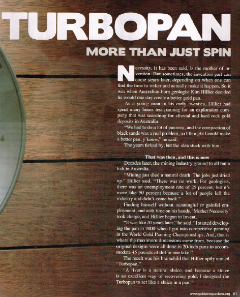Sunday, November 20 2016
Recently, Gold Prospectors magazine published an article in the November/December 2016 issue about the Turbopan. Read an excerpt of that article below: Turbopan was designed by Kim Hillier, an Australian geologist and prospector with over 20 years experience in "A river is a natural sluice, and because a sluice is an excellent way of recovering gold, I designed the Turbopan to act like a sluice in a pan," explains Mr. Hillier. The pan's riffles act like a circular sluice and were designed to use gravity to accelerate the gold to the bottom of the pan. The bottom well of the Turbo pan is in the center of the pan-- as far away from the lip of the pan as possible, so you don't accidentally lose any of your precious metal. The design of the Turbopan combines the best features of the traditional batea, a deep conical shaped wooden bowl used as far back as the Mayans, and the basic copper pan used in the Klondike Gold Rush. The unique design allows the whole circumference of the pan to eject waste material and many more riffles trap much more gold. This is a huge advantage over traditional pans which tend to concentrate all material on one side of the pan. "The Turbopan is really fast!" says Hillier. "You've got maximum riffles if you're panning out over the front and also you can get the waste out before you start the clean up. It's sort of a bit of a hydrocyclone as well if used to its maximum ability, and its also good for wet sifting through gravels for gems." How to Use the Turbopan: 1. Place your material in the Turbopan. Be careful not to overload it. The pan is meant to hold up to about pounds. With the clean-up riffles facing away from you, submerge the pan into water, and then spin the pan counter-clockwise and then clockwise 180 degrees to allow the water to saturate the materials. TIP: Use a catch tub so you don't lose any gold in a fast-flowing stream! 2. Before panning, use your finger to feel the texture of the material in the bottom of the central trap. Does it feel too tightly compacted? If so, simply shake up the material for better stratification. 3. With your Turbo pan partially submerged, begin moving it in a counter-clockwise circular motion so that the material moves over the circular riffle bed. This action will break up clumps of dirt and prevent compaction. 4. Because gold-bearing black sands are much heavier than dirt and gravel, it will sink and become trapped in the spiral riffle grooves and gravity will move gold into the central trap. The circular motion creates centrifugal force, pushing light sands and clays to the outside of the pan, leaving the heavier black sands and gold in the center of the pan. Alternate between a "centering swirl" to get the gold-bearing heavies to the middle of the pan and the "lights" to the surface, and an "ejection swirl" to get rid of the waste materials. 5. Because the pan is shallow, you'll notice how easily you can clear the small rocks, pebbles and debris from the pan with a single sweep of your hand. 6. When the amount of material remianing in the pan barely covers the central trap, do two or three more clockwise swirls, then about five seconds of vigorous back-to-front and side-to-side motions. 7. Tilt the pan away from you and gently shake it side to side while tilting the pan up at about a 30 degree angle. 8. Pan off any waste until you have only a small amount of concentrates containing gold (about the diameter of a 50 cent piece). 9. Tilt the pan towards you and look for your gold in the bottom of the central trap. 10. If you see gold in the cleanup riffles, don't worry. With a little more practice you'll master your own technique. To watch how-to videos or shop for the Turbopan, click here. |
|
Nugget of News Blog |







